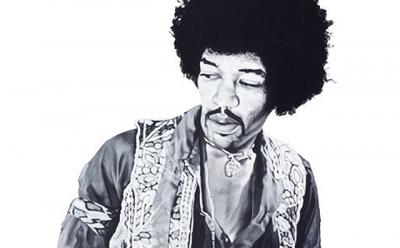The Golden Age of Rock ’n’ Roll at Bridgehampton's White Room

There’s a popular posting you may have seen on social media, in which photographs and quotes by Kanye West and Jimi Hendrix are paired. The former declares himself “a creative genius, and there’s no other way to word it.” That is juxtaposed with the latter’s declaration that “I wouldn’t say that I’m the greatest guitarist ever. I’d say probably that I’m the greatest guitarist sitting in this chair.”
The shyness and humility of Hendrix, who indisputably revolutionized the guitar and rock ’n’ roll and, 46 years after his death at age 27, continues to influence music, is emblematic of musicians from another, very different, era. It came to mind while gazing at the Australian painter Adoni Astrinakis’s depiction of the musician, which is a prominent feature in “The Golden Age of Rock ’n’ Roll,” a two-part exhibit at the Mannix Studio of Art in East Hampton (Part 1) and the White Room Gallery in Bridgehampton (Part 2). Mannix hosted an opening reception on Saturday, the White Room on Sunday.
Mr. Astrinakis’s painting, part of his first American gallery show, depicts a pensive Hendrix, alone against a stark background, his gaze far from the viewer and his mind apparently farther away still. Those who were in his presence sometimes describe him as otherworldly, as though the laws of gravity and the material world simply did not apply.
The artist’s rendering of Hendrix, from his “27 Club” collection, depicting the eerily substantial number of musicians who died at that age, is one of the standout works of “The Golden Age of Rock ’n’ Roll.” Also featured from that collection at the White Room are a brash and doomed Amy Winehouse, her right arm thrown across her body as though guarding her soul against those who would steal it, and Kurt Cobain, hands up as if in self-defense, similarly ill at ease in the world.
Of course, the White Room exhibit, which runs through Sunday, is full of rock ’n’ roll’s rampant jubilation as well. On a wall adjacent to the brooding Hendrix is Steve Joester’s collage of a circa-1970s Mick Jagger, androgynous and positively electrifying amid swaggering performance.
Also represented in the Bridgehampton show are Laura Benjamin’s candy-wrapper collages of Michael Jackson, Mr. Jagger, and Elvis Presley; the artist Evad’s glitter-on-canvas renderings of the late David Bowie, Prince, and John Lennon, as well as Mr. Jagger (again). Photography, such as Bonnie Lautenberg’s depictions of provocative contemporary artists including Lady Gaga and Miley Cyrus, and EJ Camp’s work for Rolling Stone magazine depicting Annie Lennox, Willie Nelson, and Billy Idol, are also on display.
Photography dominates at the Mannix Studio’s exhibition, which runs through June 19 and was the catalyst for “The Golden Age of Rock ’n’ Roll,” said Karyn Mannix, the studio’s proprietor. Chris Foster, a Londoner who relocated to the South Fork, had given Ms. Mannix’s brother a print of one of his 1970s photos of Bowie. “I said we should work together,” she recalled telling Mr. Foster, “and then David Bowie died. It’s the perfect thing for the grand opening, and this is really iconic rock ’n’ roll. There are no modern people in here.”
Here, the glam and the grit of rock ’n’ roll, some as manifested in 1970s New York City, are prominent. Pop artists including Boy George and Elton John are depicted, as are the early-’70s British rockers the Faces, featuring a much-younger Rod Stewart and Ron Wood, but so are punk rockers like the Ramones, Johnny Thunders, Cheetah Chrome, and the Kretins. Also featured are Susan Wood Richardson’s photographs of Lennon and Yoko Ono, which were exhibited last summer and fall at the Mulford Farm Museum in East Hampton. Another highlight is a series of portraits by the late Jack Mitchell, including David Byrne, Philip Glass, and Cat Stevens.
Saturday’s reception at the Mannix Studio included a book-signing of “Punks, Poets, and Provocateurs: New York City Bad Boys, 1977-1982” by Marcia Resnick, and art created by children in the classes offered at Mannix.
Like the art form itself, “The Golden Age of Rock ’n’ Roll” portrays youthful expression in its sprawling, disparate emotion, exuberance, vulnerability, and power. Each exhibit is a self-contained joy; taken together, they form a dazzling, glittering portrait of their subject.
